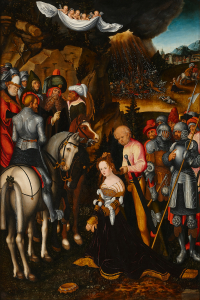South German Baroque House Altar
South German Baroque House Altar
This South German house altar, probably made in Augsburg or Munich, is with certainty by the hand of a very skilled, as yet unknown, master sculptor. Both the centrally placed relief and the Mannerist execution of the altar that encloses the relief were created with enormous virtuosity. Also the very refined and detailed execution of the sculpture contributes to the assumption that a master has been at work here. These small house altars were a very luxurious, precious and rare commodity.
The altar includes a finely sculpted relief depicting the subject of the Lamentation of Christ. The subject of the lamentation is frequently depicted in art. It is the moment between the Descent from the Cross and the Entombment. Since the eleventh century this representation has been a integral part of the cycles of the life of Christ, despite the fact that it is not described in the Bible.
Christ's body, just taken from the cross, hangs limp in the womb of his mother Mary. His arms are spread. She is supported by John, to whom Jesus had entrusted the care of his mother from the cross. Three holy women bewail Christ. Mary Magdalene can be recognized by her ointment jar. In the background, the ladders are removed from the cross. Nicodemus watches from a cave, Christs’ tomb. According to the Bible, he would embalm and bury Christ. Although this home altar is described as Pieta in the catalog of the Laren exhibition in 1958, it is a lamentation and not a Pieta. Only Mary, Christ and possibly angels are depicted on a Pieta. Because there are more minor characters in this scene, this is called a lamentation.
On the sides of the altar are two free standing sculpted disciples. One seems to look around the edge of the frame at the scene and the other looks up in rapture. Because the attributes, the symbols by which they can identified, are missing, it is impossible to say which disciples are involved.
In the tympanum of the altar an oval cartouche with a family crest with a soaring eagle turned towards a radiant sun is visable. This family crest can be identified as that of the northern French noble family Remy (Remÿ), also called Remy de Campeau.
Due to the presence of this family crest in the cartouche it is possible to establish with great certainty that they once owned this altar. However, they were certainly not the commissioner, because this cartouche is made of a different type of wood and of a later date. In addition, they were not raised to the peerage until 1758.
Exhibition:
Kunstbezit rondom Laren 13de-20ste eeuw: schilderijen, beeldhouwwerken, Singer museum Laren 1958 no. 53 (as Italy 16th century).
- Provenance
- Most likely in possession of the family Remy de Campeau;
The Brenninkmeijer family in Naarden. - Period
- ca. 1610
- Material
- walnut veneered with ebony and sculpted pear wood
- Dimensions
- 46 x 34 x 8.5 cm
Global shipping available












